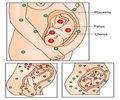A new study has revealed that pregnant women with high normal blood sugar levels are more likely than women with lower blood sugar levels to give birth to babies at risk for many of
Pregnant women with high normal blood sugar levels are liable to give birth to babies at risk of developing similar problems as babies born to women with diabetes during pregnancy, a new study has indicated.
These risks include a greater likelihood of the baby being delivered by Caesarean section, the baby being large at birth and the baby's shoulder becoming stuck in the mother, which halts delivery.This risk assessment applies to pregnant women who have high blood sugar levels, but who are not considered to have diabetes, versus women with normal blood sugar levels.
The researchers could not identify a specific blood-sugar level above which the health problems were likely to occur. However, they did notice that the risks increased in relation to a rise in the women's blood sugar levels.
The current study is the first to document that higher blood sugar levels, not high enough to be considered diabetes, also convey increased risks for both mother and the child.
Furthermore, when the researchers mathematically adjusted for other potential causes of these risks, such as older maternal age, obesity, and high blood pressure, the increased risks due to higher blood sugar levels were still present.
"These important new findings highlight the risks of elevated blood sugar levels during pregnancy," said Duane Alexander, M.D., director of the NIH's Eunice Kennedy Shriver National Institute of Child Health and Human Development, which provided much of the funding for the study.
Advertisement
Dr. Metzger explained that before the current study, physicians were not sure at which point elevated maternal blood sugar posed a risk for the baby.
Advertisement
For this reason, it wasn't known whether the increased risk for Caesarean delivery and other problems seen with mild elevations in blood sugar during pregnancy were caused by the elevated blood sugar levels, or by these accompanying conditions.
However, in the new study, the researchers made adjustments for these accompanying conditions and found that the higher blood sugar levels still conveyed increased risks.
For the study, the researchers performed an oral glucose tolerance test on each woman, from the 24th through the 32nd week of pregnancy.
For the test, the women fasted, after which their blood glucose level was measured.
Next, the women drank a glucose solution, and then their blood glucose was measured at predetermined intervals.
Women with blood sugar levels high enough to raise safety concerns were referred for treatment and were not included in the study.
The remaining women were observed throughout the study until they gave birth.
The researchers found that the higher the mother's blood sugar levels, the greater the chances that they would deliver by Caesarean section.
Besides this, they found that higher the mother's blood sugar levels, the more likely the infants were to have high insulin levels and low blood sugar levels at birth.
Moreover, the higher the mother's blood sugar levels, the more likely the women were to develop preeclampsia (a potentially fatal disorder involving dangerously high blood pressure), and the more likely their infants were to be born prematurely, and to experience shoulder dystocia.
"These relationships are continuous and generally increase incrementally over the range of blood glucose levels we saw in the study," Dr. Metzger said.
The study is published in the New England Journal of Medicine.
Source-ANI
RAS/L











